How to Draw a City in One Point Perspective TUTORIAL
Last Updated on May 27, 2021
This article contains everything an Fine art student needs to know about drawing in 1 signal perspective. It includes pace-past-step tutorials, lesson plans, handouts, videos and gratis downloadable worksheets. The textile is suitable for eye and high school students, as well as any other person who wishes to learn how to draw using single point perspective. It is written for those with no prior experience with perspective, beginning with bones concepts, earlier working towards more complex three-dimensional forms.

I point perspective: definition
Dictionary.com ascertain i point perspective as:
…a mathematical system for representing three-dimensional objects and space on a two-dimensional surface past ways of intersecting lines that are fatigued vertically and horizontally and that radiate from one point on a horizon line…
Although this definition sounds complicated, the concept is relatively uncomplicated. I indicate perspective is a cartoon method that shows how things announced to get smaller as they become further away, converging towards a single 'vanishing point' on the horizon line. It is a way of drawing objects upon a apartment piece of paper (or other cartoon surface) so that they look three-dimensional and realistic.
Drawing in one betoken perspective is ordinarily appropriate when the subject is viewed 'forepart-on' (such as when looking directly at the face up of a cube or the wall of building) or when looking straight down something long, like a route or railway track. It is popular drawing method with architects and illustrators, especially when drawing room interiors. To understand more nearly the history of perspective in art, please read our accompanying Guide to Linear Perspective (coming before long).
Note: If you need to describe something that is not facing you directly, but rather has a corner nearest to you, two point perspective is probable to be more advisable.
Rules of perspective: true shapes, vanishing points and horizon lines
In i point perspective, surfaces that confront the viewer appear as their true shape, without whatever distortion. They are fatigued using primarily horizontal and vertical lines, as illustrated by the diagram below:

Surfaces that travel away from the viewer, on the other hand, converge towards a single 'vanishing point'. This is a bespeak that is located directly in forepart of the viewer'due south optics, on a 'horizon line' (besides known as an 'eye level line'), equally illustrated in the photograph below:

It is possible to draw over photographs to identify vanishing points, horizon lines and true shapes. Studying the piece of work of famous artists can as well help you lot gain an agreement of one point perspective, as shown in the example by Vincent van Gogh below.
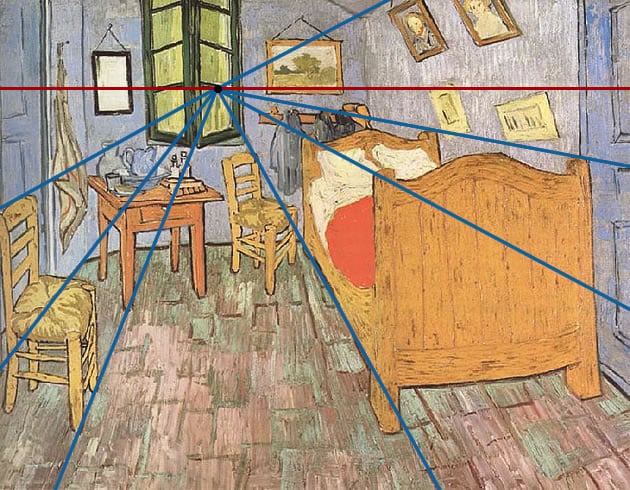
Key Points:
- Surfaces that face up the viewer are drawn using their truthful shape
- Surfaces that travel away from the viewer converge towards a single vanishing indicate
I indicate perspective tutorial
The following tutorial explains how to draw one point perspective footstep-past-pace. The exercises are designed to be completed in the order given, with each one building upon the previous task. All worksheets are available equally a freeperspective cartoon PDF that can be printed at A4 size (more worksheets volition be added to this over fourth dimension).
The downloadable PDF has been provided by the Educatee Art Guide for classroom utilise and may exist issued freely to students (credited to studentguide.com), as well as shared via the social media buttons at the lesser of this folio. The worksheets may not be published online or shared or distributed in any other mode, as per our terms and weather.
Recommended Equipment:
- Mechanical or 'clutch' pencil (with an HB or 2H lead)
- Blank paper and/or the printed worksheets
A ruler and compass tin be useful while learning to draw in one point perspective, however most Art students find that these exercises are best completed freehand, with dimensions and proportions gauged by eye. This is so that the skills are hands transferrable to an observational drawing.
EXERCISE 1: CUBES AND RECTANGULAR BLOCKS
Cartoon rectangular blocks is ofttimes the first ane bespeak perspective lesson given to students. Information technology is a unproblematic exercise that provides a solid foundation for things to come.

This worksheet explains how to draw a cube in ane signal perspective and takes you through drawing these higher up, below and in line with the horizon line. It introduces the importance of line weights and highlights the effect of positioning objects in relation to the horizon line.
By the completion of this do, you lot should be able to:
- Use advisable line weights (light lines for construction lines; nighttime lines for outlines)
- Position a vanishing point and horizon line correctly
- Understand that:
- Objects above the horizon line are drawn as if you are looking up at them (you see the bottom of the object)
- Objects beneath the horizon line are drawn as if yous are looking down at them (you lot run into the summit of the object)
- Objects that are neither above nor below the horizon line are drawn as if you are looking directly at them (you lot meet neither the top or the lesser of the object)
This information is demonstrated in the video tutorial below:
Exercise 2: stacking, holes and angles

This worksheet illustrates how to stack blocks, cutting away portions and add unusual angles in a one point perspective drawing, creating gradually more complex forms.
By the completion of this practice, you should be able to:
- Draw stacked blocks of different sizes
- Draw blocks that have holes cut out of them, projecting construction lines to observe the dorsum border of the cut area
- Slice pieces off blocks and/or add together unusual angles
In one case you lot experience confident with drawing these items, yous may wish to add more challenging forms, such as letters and/or triangular shaped prisms.
The post-obit video helps to explain how to draw ane signal perspective cartoon step-by-step:
An artist example of perspective past Robert C. Jackson:

Do iii: perspective block messages
Drawing block lettering in one point perspective is a relatively straight-forward chore, suitable for a homework action.
The following video demonstrates how to practice this:
Practice iv: finding centres and equal spaces
This video explains how to as carve up items in ane indicate perspective, assuasive you to draw argue posts, lamp posts, and as spaced windows or buildings.
By the completion of this practise, you should exist able to:
- Detect the middle of whatsoever rectangular surface using the 'corner to corner' method (this works even on surfaces that are receding towards the vanishing indicate)
- Split up the surface of any rectangular block into any number of equal parts
- Draw tiles on a floor in one point perspective
- Draw repeating elements, such as fence posts, receding into the distance
This is explained in the following video tutorial:
Exercise v: i betoken perspective cityscape
Drawing a road and surrounding cityscape (either imagined or observed from existent life) is a neat follow-up activity to the previous exercises. A one signal perspective street scene typically combines repetitive manmade elements with stacked, cutting and angular forms. This exercise can be as challenging or minimal as desired, allowing able students to motion ahead and produce detailed, elaborate drawings.
One indicate perspective city scene past Lichtgestalt00:

A suburban scene by Karina Barabanova:

A one betoken perspective painting past Gustave Caillebotte:

A sketch by Daniyar:

Do 6: circles and curves
The well-nigh challenging aspect of perspective is drawing curving or circular forms. These are typically sketched freehand, inside squares or rectangles to help get proportions correct.
Key points:
- Employ the technique of 'crating' – drawing complex forms within rectangular boxes
- Employ straight lines (guidelines) to aid the cartoon of irregular curves, such as the curving forms of rivers or trees in a 1 signal perspective landscape
- Empathise that:
- Circles or curving forms that face the viewer are drawn using their true shape
- Circles that recede towards the vanishing point appear distorted, appearing smaller every bit they become farther away
A 1 point perspective cartoon by Stephanie Sipp, a professor at Florida State College of Jacksonville, Interior Design department:

A perspective landscape by Vincent van Gogh:

A drawing by high school pupil Estherlicious:

Practise seven: one point perspective room
The most common perspective cartoon lesson is a 1 bespeak perspective room. Interiors combine a multitude of skills and can be made as challenging or involved as required. Perspective flooring allows y'all to practise dividing surfaces into equal spaces, while the questions of how to draw a window in perspective; article of furniture / desks / beds; or bordering corridors etc provide a challenge regardless of your power level. To gain ideas virtually how you might approach drawing interiors in perspective, nosotros have included a range of examples below, including bedrooms, living rooms, kitchens and hallways. Drawing a room in ane betoken perspective can exist great practice for those who wish to afterward pursue interior blueprint, architecture or for those who are studying Design Technology at high school.

The illustration above shows a one bespeak perspective grid (this may exist downloaded and printed for classroom apply) which may be drawn on directly or traced over, using a lightbox.
To understand how to draw a room in 1 point perspective, please view our step-by-step video:
Please note that this video is not captioned, equally information technology is hoped that the challenging aspects of this exercise are explained earlier in this guide.

A one point perspective room by Dutch renaissance architect, painter and engineer, Jans Vredeman de Vries:
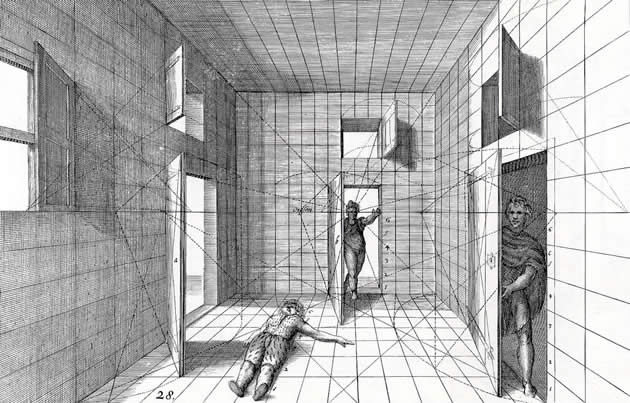
A one betoken perspective interior by Amani Cagatin:
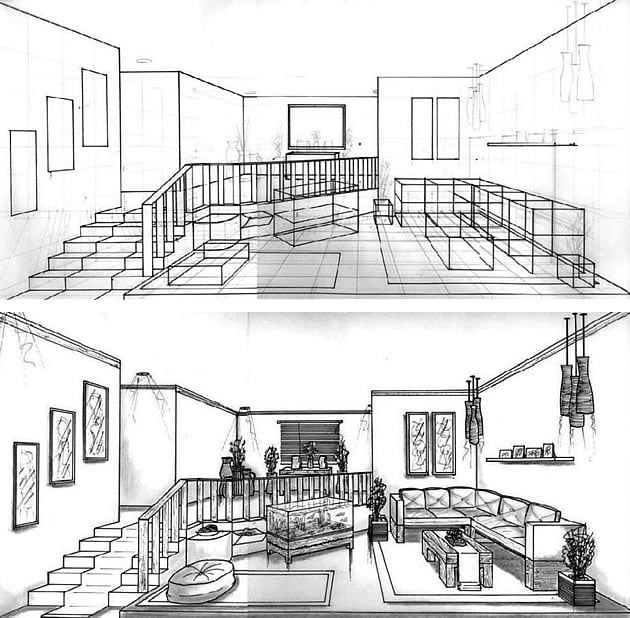
A 1 signal perspective bedchamber by Cheryl Teh Veen Chea of One Academy:

A one point perspective kitchen by Dana Bailey:
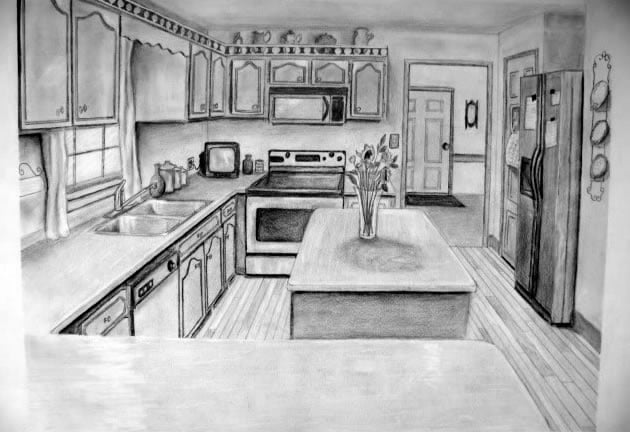
A i point perspective hallway by Jake Mutch, completed while studying Fundamental Arts at Kingdom of the netherlands College:
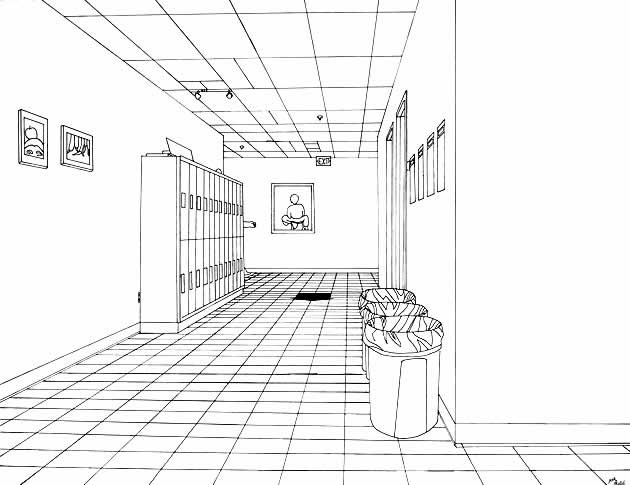
A perspective interior by S.Kim:
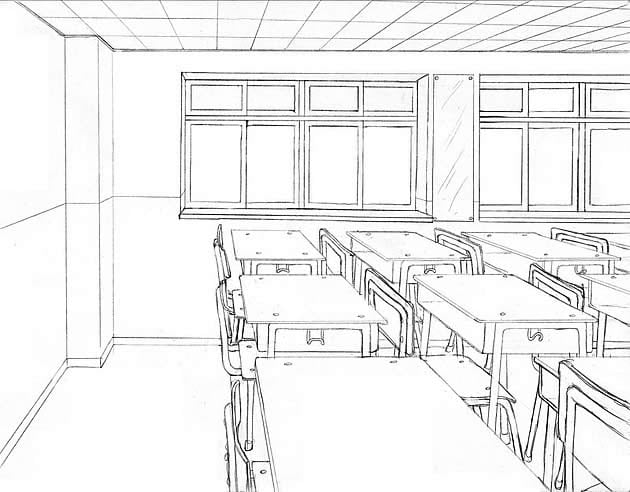
A cartoon by Abby Hope Skinner, whose Top in the Globe A Level Fine art project has also featured on the Student Art Guide:

This guide is office of our Essential Lessons for Fine art Students (a series of manufactures packed with downloadable teaching resources) such as our guide to line drawing. This is a work in progress and will be added to over time!

Amiria has been an Fine art & Blueprint teacher and a Curriculum Co-ordinator for seven years, responsible for the course pattern and assessment of educatee work in two high-achieving Auckland schools. She has a Bachelor of Architectural Studies, Bachelor of Architecture (First Grade Honours) and a Graduate Diploma of Teaching. Amiria is a CIE Accredited Fine art & Design Coursework Assessor.
DOWNLOAD HERE
How to Draw a City in One Point Perspective TUTORIAL
Posted by: lamarught1979.blogspot.com

Comments
Post a Comment